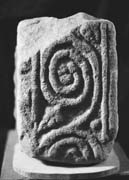Select a site alphabetically from the choices shown in the box below. Alternatively, browse sculptural examples using the Forward/Back buttons.
Chapters for this volume, along with copies of original in-text images, are available here.
Object type: Part of shaft [1]
Measurements: H. 29 cm (11.5 in); W. 18 cm (7 in); D. 10 cm (4 in)
Stone type: Yellowish grey (5Y 7/2), poorly sorted, clast-supported, quartz sandstone. The sub-angular to sub-rounded clasts range from medium-grained (0.3 mm) to granular (2.5 mm), but are mostly medium- to coarse-grained in the range 0.4 to 1.0 mm. ?Ward's Stone Sandstone Formation, Millstone Grit, Carboniferous
Plate numbers in printed volume: Ills. 458-61
Corpus volume reference: Vol 9 p. 175
(There may be more views or larger images available for this item. Click on the thumbnail image to view.)
A (broad): Flanked by both the roll-moulding border and a narrower inner moulding, decoration consists of a single-stemmed spiral scroll. One complete spiral survives, together with half of the spiral beneath. A three-pellet fruit cluster terminates the surviving spiral and a pointed and veined leaf drops to the left from this spiral. A single pellet fills the space to the right between the upper and lower spirals and the border, whilst a second pointed leaf is visible in the upper right corner.
B (narrow): A single border moulding survives to the left. Ornament consists of a single-stemmed spiral scroll with a pellet placed between the border and the split of main stem and spiralling offshoots. Two spirals remain, each ending in a round leaf or fruit. A pointed and veined leaf drops from the upper spiral.
C (broad): The lateral borders are as on face A, though badly damaged. Most of two volutes of a single-stemmed spiral scroll remain within the frame. The scrolls terminate in a rosette fruit cluster, and the upper volute carries a veined and pointed drop-leaf emerging from the inner part of the spiral. There is a pellet in the lower right corner of the surviving panel.
D (narrow): Traces of both lateral borders remain. Within are two volutes of a spiral scroll terminating in a single round leaf or fruit. There is a damaged pointed and veined leaf in the upper left corner, and a distinctive veined drop-leaf emerging to the right from the upper complete volute. A single fruit pellet fills the space to the left between the volutes and the border.
Like many Lune valley shafts, this stone carried scroll on all four faces. In its details it echoes forms found elsewhere within both the Lune valley set and on the related shafts at Heversham and Lowther in Cumbria (Chapter IV, p. 19), whilst the combination of double and single borders is used at Lancaster and Hornby. Equally, scroll forms without fruit at the centre of the spiral, but with a drop leaf emerging from within the spiral, recur at Halton St Wilfrid 6, Halton Green 1, Lancaster St Mary 2 and 3, and Lancaster Vicarage Field 1 (Ills. 492, 504, 570, 574, 580, 606). In a more complex form, with the stem of the drop-leaf emerging from the centre of the spiral, the type can be seen at Heysham 1 and further north at both Irton and Lowther (Ills. 514–15; Bailey and Cramp 1988, ills. 367, 437). In addition, within the same group, are forms with a pellet at the junction of scroll spirals (Lancaster St Mary 8, Ill. 596).



